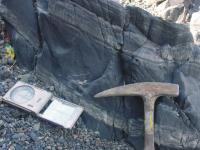Special Program for International Students
GRADUATE COURSE IN EARTH SCIENCE
& GEOENVIRONMENTAL SCIENCE
Course Content

TERMS OF THE PROGRAMS
For international students the academic year begins in October and ends in September, whereas for Japanese students the year starts in April and ends in March. Early graduation (after one year or one and half years for the Master's course, and one to two and half years for the doctoral course) is available for exceptional students should they complete the requirements for their course ahead of time.
OUTLINE OF THE COURSES
The Master's and doctoral programs are both grouped into three courses, namely Advanced Earth Science, Earth Resource Science and Technology, and Geoenvironment and Natural Hazards. All courses are conducted in English.
Advanced Earth Science
Advanced and international-level research in solid earth science, including geology, paleontology, igneous and metamorphic petrology, mineralogy, inorganic and organic geochemistry, geochronology, structural geology, and geodynamics.
Research of large-scale material circulation and geodynamics from the core-mantle boundary to the surface of the earth, and spanning the period from the birth of the earth to the present day. This includes the evolution of the biosphere, which it is closely related to material circulation and to geodynamics.
Earth Resource Science and Technology
Research on metallic mineral resources such as gold, silver, copper, lead and zinc; non-metallic mineral resources including zeolites, silica sands, feldspars, and clays; and fossil fuel sources such as petroleum, coal, natural gas, and methane hydrate. Research on soils, groundwater, the land and forests from the viewpoint of material circulation at the earth’s surface. The occurrence and origin of the above resources, and heir evaluation and development.
Geoenvironment and Natural Hazards
Research on natural processes at the earth's surface and their products, including paleoenvironments, Quaternary geology; environmental geology and geochemistry, and earth history. Research of natural hazard engineering, including volcanology and volcanic hazards, engineering geology and natural hazards such as slope failures, geotechnical engineering and soil mechanics and their practical application, and subsurface fluid engineering.
Students may study in any of the above fields with the agreement of their supervisor. Additional credit courses are also given in Current Topics in Geoscience and Methodology (including Scientific Writing & Graphics), Specialist Seminars, field excursions, and for attendance at invited lectures.
Formal requirements for the Master's consist of a total of 30 credit hours over two years. Of these, 12 credits are for the research thesis (as supervised by the academic advisor), and 18 credits are elective lecture courses or seminars. Most of elective credits are earned in the first year. The elective 4-credit courses offered cover most major areas of Earth and Geoenvironmental Science.
On enrollment, each candidate in the Doctoral Course is assigned an academic advisor who will supervise the research in the designated academic discipline for the three years of the course. The Doctor of Science, Engineering or Philosophy degree will be granted in recognition of this thesis research. Formal course work of 12 credits is required, comprising thesis work (4), and lectures and seminars (8).
NUMBERS TO BE ADMITTED
A total of three students may enter the Master's course, and two students may enter the doctoral course each year.
ADDITIONAL INFORMATION
Additional information on the qualifications required for entry, limitations, and the procedure for application to this course is given in the guidebooks linked to the front page.
Inquiries may also be directed to:
Admissions Division, Shimane University
1060 Nishikawatsu-cho, Matsue, Shimane
690-8504 JAPAN
e-mail: sad-nyushi03@office.shimane-u.ac.jp
Fax: +81-852-32-6059
